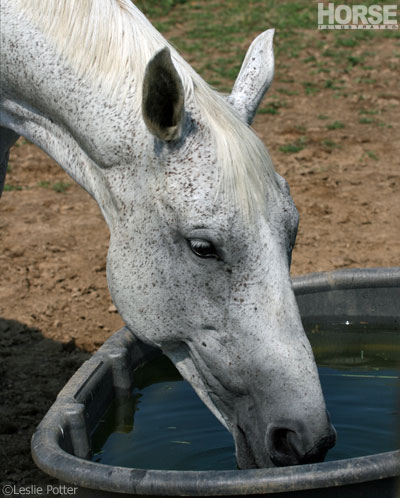 Q: I have heard that you can’t let a horse drink water if he’s
Q: I have heard that you can’t let a horse drink water if he’s
still hot after working because it can cause colic. I’ve also been told that you shouldn’t hose
your horse down when he’s hot because it can cause tying up. However, I’ve also been told that the
opposite is true, and hosing your horse down and letting him drink right after exercise is good
for him. Which is right?
of water per day. This is a maintenance level of hydration, meaning if this horse is worked, his
hydration needs will increase. For example, a horse can lose between five and eight liters of
sweat an hour on a long-distance ride in hot temperatures, and a racehorse at a sprint may lose
one to five liters. These large losses in the body’s water and delicate electrolyte balances mean
you never want to withhold water from a thirsty horse – dehydration will cause many more problems
than a threat of theoretical water-overload. In fact, dehydration and the havoc it can cause are
responsible for most of the problems that have given way to the misguided directive
of restricting water intake from a hot horse.
The key when offering a hot horse water is to offer small amounts frequently; the goal is to
maintain a certain level of hydration instead of retroactively trying to fix exercise-induced
dehydration later. If you are out on a trail ride for more than an hour, letting your horse to
take some gulps from a local stream during the ride is perfectly acceptable, as is letting him
have, say, a third of a bucket of water upon return. Offer him another third of a bucket fifteen
to thirty minutes later, after you’ve groomed and cleaned up a bit, then offer a full bucket for
the horse to consume at his leisure.
Properly cooling down a horse will also help with the recovery process. Most riders
intrinsically know not to merely stall a horse whose nostrils are still flaring from a hard ride.
Like any human athlete after a workout, a worked horse needs to be cooled down as well. Walk him
quietly for at least five minutes. This will help return his heart rate to normal levels while
maintaining circulation. A proper cool down also acts to help stretch the horse a little, allowing
his body to properly and efficiently metabolize wastes such as lactic acid that have built up in
his muscles.
This brings us to the second part of your question regarding hosing down a hot horse. It is not
true that hosing a hot horse will cause tying up, also known as exertional rhabdomyolysis,
azoturia, or Monday morning sickness. This serious condition occurs for two main reasons: either
the horse has an underlying myopathy such as a breed specific polysaccharide storage disease which
basically causes pathologic muscle breakdown, or the horse has been physically overexerted beyond
his limits. Simply hosing a hot horse off contributes to neither one of these scenarios. Instead,
it will help lower a horse’s body temperature and remove sweat-encrusted particulate material from
the skin, which can be a cause for dermatologic issues.
See more Expert Q&As >>
Submit your Ask the Expert question >>
Liked this article? Here’s more on keeping your horse healthy in hot weather.
10 Tips to Stay Safe in Hot Weather
Too Hot to Trot?
Anna O’Brien, DVM, is a large-animal ambulatory veterinarian in
central Maryland. Her practice tackles anything equine in nature, from
Miniature Horses to zebras at the local zoo with a few cows, goats,
sheep, pigs, llamas, and alpacas thrown in for good measure. Follow her on Twitter: @annaobriendvm.






Glad to see these myths busted right on the front page! I’m sure many a hot, sweaty horse would thank you.
Great advice! Thank you!
Very interesting! I’ve always wondered that too.
Thanks for the information.
Thanks for printing these tips! Most of it I already knew, but I learned a few new things!
Good reminder.
I’m glad this was addressed, it never made sense to me to keep a hot thirsty horse from drinking, I know I’d be in torment in the horse’s place!
The vet I worked for in the past always instructed us to cool down the legs and extremeties with cool water before hosing down the chest so you don’t shock the internal organs.